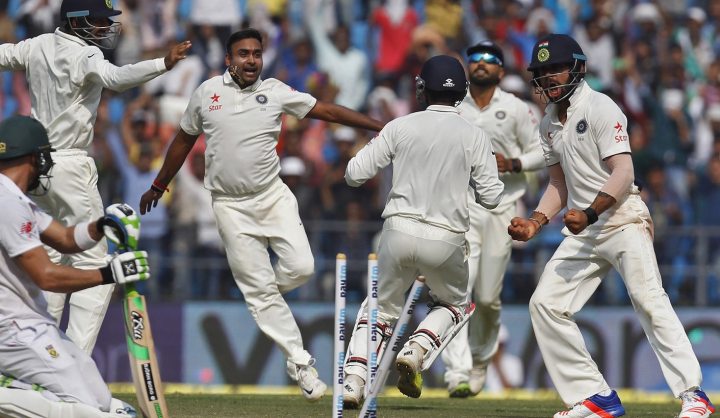Sport
Five lessons for South Africa after their series defeat in India

A 3-0 defeat in a series where the team collectively managed just two half-centuries, both of them coming from the same player, means that South Africa will return home with their tail between their legs. ANTOINETTE MULLER picks five of the lessons South Africa learnt on this tour.
South Africa will return home from India beaten, but not broken. Before this series began, very few would have imaged that they would end up being so completely outclassed. Not a single one of India’s batsmen had over 40 caps when this series began, and their bowling was just as inexperienced. South Africa had not lost a series away from home in nine years and although they had a few new faces in the squad, they were still the favourites on paper.
However, extreme conditions, lack of mental application and probably a bit of mental fragility conspired to leave the Proteas wilted. Luckily for them, the 3-0 walloping does not affect their number one ranking, but they will need to put in an epic performance against England to retain it. Positives from this series were few and far between, but there were plenty of lessons and we’ve picked five of them:
Dane Vilas is not ready for international Test cricket
Dane Vilas found his way into the Test squad after Quinton de Kock was banished for bad batting behaviour in Bangladesh. Despite regaining his form on his repentance tour with the A-team to India, De Kock did not make the cut, and it severely cost South Africa. While Vilas is a very good domestic cricketer, he is not up to scratch internationally yet.
De Kock should have been the wicketkeeper on this tour, especially considering his record in limited overs against India. While De Kock has had his own struggles against spin the past, he has worked on those and, despite his young age, is actually more experienced than Vilas in playing it. If South Africa were not set on throwing the youngest to the wolves, Thami Tsolekile should have been given a shot. Not only is he the best gloveman in the country, he is feisty as hell and there is no way he would have fared worse with the bat than Vilas.
There is depth in the fast bowling department
For years, South Africa had the luxury of an injury-free Dale Steyn. Because the speedster has a mostly natural action (as natural as hurtling a bowl at 140km/h at somebody can be) he has not really been troubled by niggles. However, as the body gets older, what was once normal is no longer so. As a result, Steyn’s niggles are starting to play up more often than not. A South African pace attack without Steyn is unfathomable, but it is one that they – and their fans – need to start thinking about. The good news is that both Kyle Abbott and Kagiso Rabada showed that they are up for the task. There is not going to be another Dale Steyn – he is a once in a generation player – but there are plenty of young, hungry and talented bowlers to make up for it.
Equally important was the way Morne Morkel bowled in this series. Probably South Africa’s best bowler – tactically and technically – in this series, Morkel relished the role of leading the attack. If he manages to keep this up against England, especially on those blitz decks on the Highveld – England’s batsmen are going to be dancing.
The Imran Tahir experiment needs to end, or he needs to be used better
Imran Tahir was South Africa’s highest wicket taker on this tour, but his stats only tell half the story. With 14 wickets at an average of 21.35 and an economy rate of 3.14, you would think that the leg spinner is an automatic choice for South Africa’s starting XI, but the stats tell only half the story. At times during this series, Tahir has looked remarkably ineffective, even on wickets that favoured him. Guilty of trying too many things in one over, and not having faith in his stock ball means that the leaks runs. Of all South Africa’s frontline bowlers he had the highest economy rate. For a team like South Africa, in a situation like India, it was a problem.
In this series, Amla’s main focus has been for his bowlers to not concede any runs. As a result, he has not allowed Tahir to bowl in long spells because he knew that he was a risk. Because Tahir has no faith in his stock delivery, he would try his wicket-taking balls and get them wrong. And so, a vicious cycle was born. In limited overs, Tahir is a gem, but South Africa need to decide what they want to do with him in the longest format of the game. Either they encourage him and allow him to bowl long spells, even if those can be expensive, or they get rid of him now and use their off spinners instead.
They can still play like the best team in the world
South Africa’s defensive approach was, in some ways, self-defeating. Every single batsman had to go against all their natural instincts. Don’t score, don’t rotate the strike, and don’t get out was the aim of the game for two days. When South Africa shut up shop, they can be incredibly resilient, and they have done so on more than one occasion over the last five years. To get something positive out of this Test, they would have batted more over than any other team ever had to save a Test, a record currently belonging to England, who slogged it out for 165 overs in Johannesburg back in 1995.
They were never going to win this Test, and with so many inexperience in the team, preservation and perseverance was always going to be the strategy. It takes an incredible effort to be able to be so insular in your batting and while it didn’t work out this time, they will take heart from the fact that they managed to find some of their mongrel. Hashim Amla currently tops the list for lowest ever strike rate of any batsman who faced more than 200 delivers, with AB de Villiers sitting in third. Those are not exactly exciting numbers, but they do tell you something about the character of these players.
They cannot play spin
No matter how much we complain about the pitches, and even if the Nagpur pitch was rated poor, there is still no excuse for the way South Africa approached the spinners. More often than not, they played the turn when there was none. They mentally capitulated in Mohali and things went to hell in a hand cart from there. While the senior batsmen showed some application in the final innings of this series, it was too little too late. Luckily for South Africa, England are only bringing two spinners – and one of them is a part-timer. DM
Photo: India’s Amit Mishra (3rd L) celebrates along with his captain Virat Kohli (R) after taking the wicket of South Africa’s Faf du Plessis (L) during the third day of their third test cricket match in Nagpur, India, November 27, 2015. REUTERS/Amit Dave
Fourth match scorecard summary: India won by 337 runs
India 1st innings 334 all out: Ajinkya Rahane 127 (215), Ravi Ashwin 56 (140); Kyle Abbott 5-40, Dane Piedt 4-117
South Africa 2nd innings 121 all out: AB de Villiers 42 (121); Ravi Jadeja 5-30
India 3rd innings 267-5 declared: Ajinkya Rahane 100* (206), Virat Koli 88 (165); Morne Morkel 3-51
South Africa 4th innings: 143 all out: AB de Villiers 43 (297); Ravi Ashwin 5-61




















 Become an Insider
Become an Insider